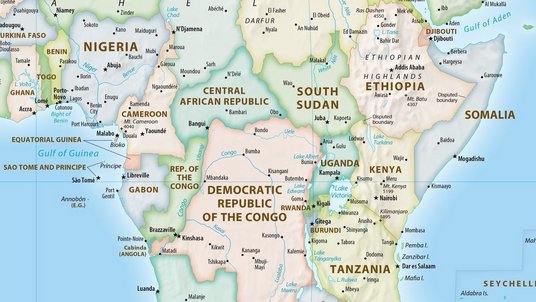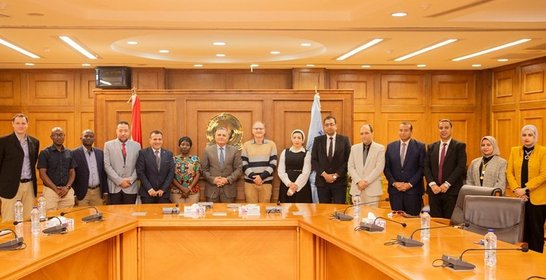
Project completed: P056_Eg_Gh_Ke_Moz_Ng_SA_Ug

Biosorbents for Sustainable Wastewater Treatment
Cooperating countries: Egypt, Ghana, Kenya, Mozambique, Nigeria, South Africa, Uganda and Austria
Coordinating institution: Suez University (SU), Prof. El-Sayed Abdelazim El-Sharkawy, president@suezuniv.edu.eg
Partner institution: Danube University Krems (DUK), Johannes Kepler University (JKU), University of Development Studies (UDS), Maseno University (MSU), Universidade Zambeze (UniZambeze), Redeemer’s University (RUN), University of Lagos (UNILAG), University of Pretoria (UP), Gulu University (GU), Kyambogo University (KYU), Nkumba University (NU)
Project duration: 1 April 2022 - 31 March 2024
Budget: EUR 40.400
Abstract
Biological materials have received increased attention for wastewater treatment such as heavy metal removal and recovery due to their good performance, low cost, and large available quantities. 2 billion people or 26% of the global population still lack access to safely managed drinking water. Inexpensive by products from agriculture are available everywhere and could have a measurable positive impact on UN-SDG 6: “Clean Water and Sanitation” if used as biosorbents for sustainable wastewater treatment.
The 2-year project “BioWaT” will pair locally available biosorbents with relevant wastewaters and evaluate the sorbents’ performance for sustainable and inexpensive wastewater treatment. The partners in this project will exchange best practices at a network meeting in Suez (Egypt) and prepare larger follow-up proposals with the aim of making sustainable wastewater treatment with biosorbents a reality not only in Africa but globally.
Summary:
The Biosorbents for Sustainable Wastewater Treatment project has successfully demonstrated the comparative effectiveness of various biosorbents for removing conventional and emerging pollutants from water and wastewater. Through interdisciplinary collaboration, project partners developed and evaluated innovative sorbent materials, utilizing diverse preparation methods and precursors to optimize adsorption efficiency. The project has yielded significant scientific advancements, with over 20 research articles published in high-impact journals. Among the key findings, the major contribution of the project is the biochar-clay composite engineered to enhance the sorption of antibiotics and industrial dyes from contaminated water. The synergistic interactions between biochar and clay significantly improved pollutant removal efficiency, demonstrating the material’s economic feasibility and scalability for wastewater treatment. Furthermore, the project explored the development of antimicrobial composites by integrating silver nanoparticles and silver nitrate with eggshell membranes, creating a sustainable solution for water disinfection. These composites exhibited remarkable antimicrobial activity, opening new possibilities for environmentally friendly water purification methods. Additionally, functionalized smectitic clay-based nano hydrated zirconium oxides were synthesized and tested for their efficiency in removing the antibiotic levofloxacin from aqueous media. This study confirmed the high stability and superior adsorption performance of the novel material, highlighting its potential for real-world water treatment applications. Overall, this project has made a substantial impact on advancing sustainable water treatment technologies. It aligns with circular economy principles and contributes to achieving the United Nations Sustainable Development Goals (SDGs) related to clean water and sanitation, responsible consumption, and environmental protection by integrating biosorbents derived from natural and waste materials.
Project Publications
Publication 1: Synthesis and Assessment of Antimicrobial Composites of Ag Nanoparticles or
AgNO3 and Egg Shell Membranes. Molecules Journal, (2023).
(http://dx.doi.org/10.3390/molecules28124654).
Publication 2: Sustainable functionalized smectitic clay-based nano hydrated zirconium oxides for
enhanced levofloxacin sorption from aqueous medium. Journal of Hazardous Materials, (2023).
(https://doi.org/10.1016/j.jhazmat.2023.131325).
Publication 3: One-Step Green Synthesis of Water-Soluble Fluorescent Carbon Dots and Its
Application in the Detection of Cu2+. Nanomaterials, (2022).
(https://doi.org/10.3390/nano12060958).
Publication 4: Cultivation of Desmodesmus multivariabilis for the Treatment of Cosmetic
Wastewater. Sustainability (2022). (https://doi.org/10.3390/su142315665).
Publication 5: Effective Adsorption of Congo Red from Aqueous Solution Using Fe/Al Di-Metal
Nanostructured Composite Synthesised from Fe (III) and Al (III) Recovered from Real Acid Mine
Drainage. Nanomaterials, (2022). (https://doi.org/10.3390/nano12050776).
Publication 6: Uranium in phosphate rocks and mineral fertilizers applied to agricultural soils in East
Africa. Environmental Science and Pollution Research, (2022). (https://doi.org/10.1007/s11356-022-
24574-5).
Publication 7: Synergistic mechanisms for the superior sorptive removal of aquatic pollutants via
functionalized biochar-clay composite, (2023). (https://doi.org/10.1016/j.biortech.2023.129593)
Publication 8: The phosphorus negotiation game (P-Game): first evaluation of a serious game to
support science-policy decision making played in more than 20 countries worldwide, (2025).
(https://doi.org/10.1007/s43621-024-00693-6)
Publication 9: Nanoclays in water treatment: Core concepts, modifications, and application insights,
(2024). (https://doi.org/10.1016/j.jwpe.2024.106180)
Publication 10: Rare earth elements and uranium in Minjingu phosphate fertilizer products: Plant
food for thought, (2024). (https://doi.org/10.1016/j.resconrec.2024.107694)
Publication 11: Towards understanding climate change: Impact of land use indices and drainage on
land surface temperature for valley drainage and non-drainage areas, (2024).
(https://doi.org/10.1016/j.jenvman.2023.119636)
Publication 12: ZnO–Polyaniline Nanocomposite Functionalised with Laccase Enzymes for
Electrochemical Detection of Cetyltrimethylammonuium Bromide (CTAB), (2024).
(https://doi.org/10.3390/jox14040106)
Publication 13: Sustainable Microbial Lead Removal Using an Upflow Anaerobic Sludge Blanket
Reactor: Advancing Eco-Friendly Solutions for Heavy Metal Remediation, (2024).
(https://doi.org/10.3390/su162310602)
Publication 14: Synthesis and Dye Adsorption Dynamics of Chitosan–Polyvinylpolypyrrolidone
(PVPP) Composite, (2024). (https://doi.org/10.3390/polym16182555)
Publication 15: Rose and lavender industrial by-products application for adsorption of Acid Orange
7 from aqueous solution, (2023). (https://doi.org/10.1007/s13399-023-04702-y)
Publication 16: Comparative Screening Study on the Adsorption of Aqueous Pb(II) Using Different
Metabolically Inhibited Bacterial Cultures from Industry, (2023). (https://doi.org/10.3390/w15244259)